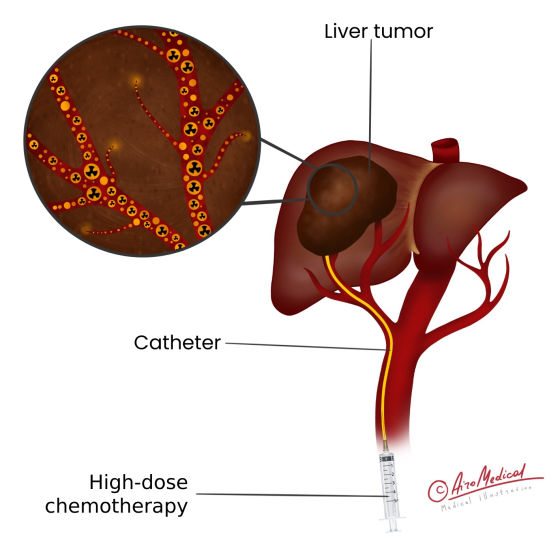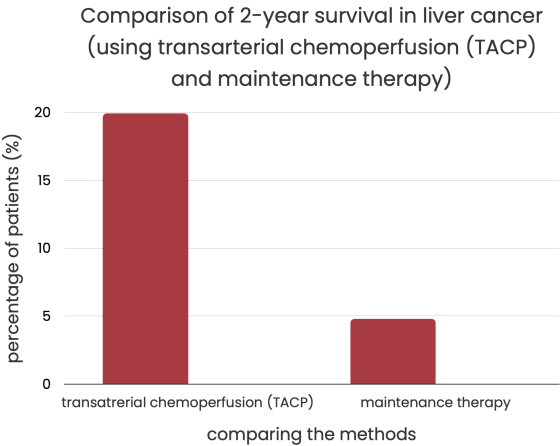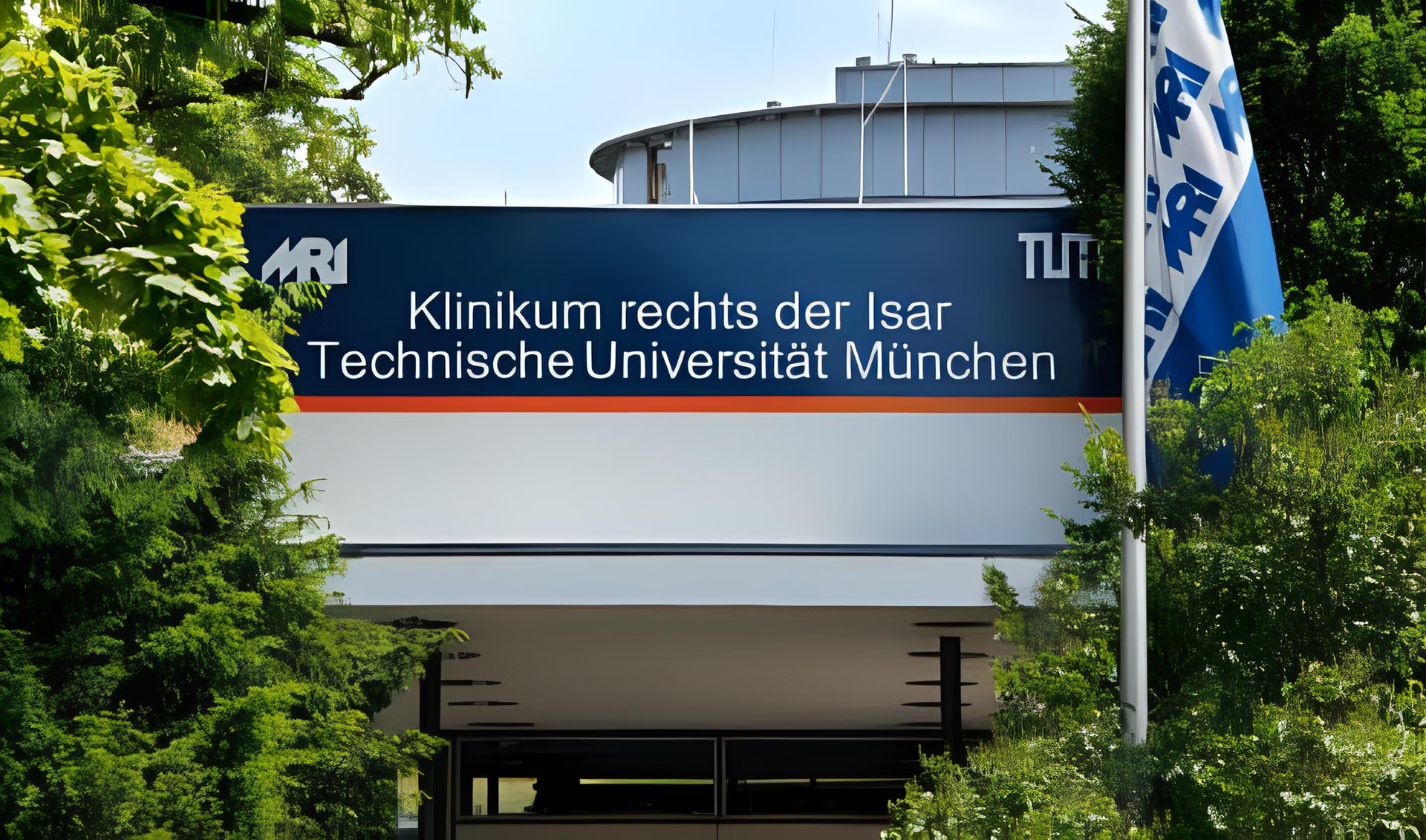Transarterial Chemoperfusion for Liver Cancer Treatment

TACP combined with brachytherapy had a 2-year survival rate of 63.5%.
84.2% of breast cancer patients with liver metastases got better with TACP.
TACP shows a 70.3% disease control rate of inoperable malignant pleural mesothelioma.
Transarterial chemoperfusion shows 70% positive results (7,5% complete response, 22,5% partial response, 40% stable) in patients with recurred and advanced pancreatic carcinoma.
 What is transarterial chemoperfusion?
What is transarterial chemoperfusion?
Transarterial chemoperfusion, also known as TACP, is a minimally invasive treatment involving putting a chemotherapeutic agent in only certain body parts, not the whole body. With the intra-arterial chemoperfusion method, a very high dose of chemotherapy can be given directly to the spot where the disease is to destroy the malignant neoplasm.
The new treatment for liver cancer is effective, has no side effects, and is meant to improve the patient's quality of life. Also, transarterial chemoperfusion has a low chance of causing adverse effects.
 How it works
How it works
The main idea behind transarterial chemoperfusion is to use different blood supplies to treat cancers in the liver and healthy organ tissues. This treatment plan is based on the following argument:
Seventy-five percent of healthy liver tissue gets its blood from the portal vein. And only 25 percent get it from arterial blood. On the other hand, hepatic arteries supply 95% of all liver cancers and metastases. The idea uses the "first pass mechanism" of the liver when a higher dose of the chemo drug can be used. It means fewer toxic medications get into the systemic circulation, so there aren't as many side effects. When chemotherapy is directly given to the hepatic arteries, the chemo drugs kill cancer cells.
Due to the transarterial chemoperfusion, the tumor shrinks, and the patient feels better, with minimal exposure to healthy cells and side effects. TACP is usually used with other treatment options, such as surgery, radiation therapy, and systemic chemotherapy.
 A detailed description of TACP for liver cancer treatment
A detailed description of TACP for liver cancer treatment
Before the procedure, the medical team makes a complex examination, including numerous imaging (CT with contrast, angiography, X-ray exam, etc.), functional, and lab tests.
 Through transarterial chemoperfusion, powerful drugs are sent to the diseased tissues. While powerful medications are sent to the healthy liver tissues causing adverse effects. In traditional chemotherapy, the cancer medicine is given through an IV, but in TACP, delivered given locally, and the drug moves through the body. It is one of the most important differences between the two kinds of treatment.
Through transarterial chemoperfusion, powerful drugs are sent to the diseased tissues. While powerful medications are sent to the healthy liver tissues causing adverse effects. In traditional chemotherapy, the cancer medicine is given through an IV, but in TACP, delivered given locally, and the drug moves through the body. It is one of the most important differences between the two kinds of treatment.
Most people need to be put to sleep for the procedure of transarterial chemoperfusion. On the other hand, the surgery can also be done with only a local anesthetic. Chemotherapy drugs are given to the liver through a catheter inserted into the blood vessel. About half an hour is set aside for the infusion to be done in the liver's main artery. Also, the chemotherapy can be heated to between 40 and 42 degrees Celsius. Higher temperatures significantly affect the tumor, but when applied locally, they are less likely to cause side effects.
When the TACP procedure is finished, the doctor turns on the filtering system that cleans the blood from the liver to get rid of chemo drugs. The doctor places a catheter in the internal jugular vein, the special equipment that cleans it, and returns it into circulation.
After the transarterial chemoperfusion (TACP) procedure, the doctor takes the catheter out of the patient's groin. Then they put a pressure bandage on the groin, watch the patient avoid complications, and manage them. Most of the time, the treatment is given between one and two times, depending on the patient.
 Who is eligible for the TACP?
Who is eligible for the TACP?
Patients with liver metastases from breast cancer and colon cancer.
The study used the kind of local chemo (transarterial chemoperfusion, or TACP) to treat patients with advanced hepatic metastatic colorectal and breast cancer lesions. They were inoperable and did not respond to treatment.
Patients with primary liver tumors (hepatocellular carcinoma or HCC).
People with advanced or unresectable stages of HCC are potential candidates for the TACP procedure. However, there are only a few studies on this category of patients to make the decision.
Patients with inoperable malignant pleural mesothelioma (MPM).
Surgery is the only effective treatment for MPM, but the disease must be found early. Only 10–20% of patients are good candidates for surgery, and there are often problems with surgery. The TACP has few adverse reactions and looks promising for helping people who have few or no other treatment options live longer.
What clinic specializes in TACP?
 Advantages and risks of the treatment
Advantages and risks of the treatment
This method is similar to other intra-arterial ways of treating liver cancer, like transarterial chemoembolization (TACE). These methods take advantage of the fact that liver tumors and healthy liver tissue get different amounts of blood. The main difference between TACP and other methods is that chemotherapy is done continuously and independently.
Transarterial chemoperfusion is an excellent way to treat liver cancer because:
- Targeted delivery: Because of the capabilities of TACP, it is now possible to administer chemotherapeutic medications in high quantities directly to the tumor. Chemoperfusion has the potential to either shrink tumors or delay their growth.
- TACP is typically performed via a minimally invasive technique, in which a catheter is inserted under the skin by making a tiny incision. It makes it a less invasive treatment option compared to others, such as surgery.
- Reduced likelihood of experiencing unfavorable effects because of using TACP. It helps prevent healthy tissue from exposure to excessive doses of chemotherapy.
- A significant drop in tumor growth and cancer after the transarterial chemoperfusion; low effect on the body because it is applied significantly;
- In severe cases, the method improves the quality of life and makes people live longer. It can be the only option for some patients.
Also, the chemoperfusion method offers a short stay in the hospital and the ability to combine with other treatments to make them more effective.
TACP also has risks like:
- Complications related to the operation, including bleeding, infection, and obstruction of blood vessels.
- Side effects of chemotherapy medications used in chemoperfusion include making patients feel sick, causing them to lose their hair, and making them more susceptible to illness.
- The development and reappearance of a tumor — TACP may only be appropriate for some patients and may only be effective for some patients.
It is essential to remember that TACP is not a typical method of administering chemotherapy. This approach is not commonly used in the medical industry as it is still in the testing or research stages and is still in clinical trials.
Who can help with TACP?
 Results and statistics
Results and statistics
TACP, also known as transarterial chemoperfusion, is an innovative and highly effective method for treating liver cancer that has already spread. It dramatically improves life quality in a variety of fundamental ways. The TACP approach is risk-free, incredibly efficient, and may be applied even with the information that has already been gathered on the patient.
TACP was evaluated with supportive therapy in a recent study by the American Association for the Study of Liver Diseases (AASLD). The study aimed to determine which transarterial chemoperfusion treatment was more effective for patients with liver metastases. Both groups contained a healthy variety of individuals. These investigations demonstrated that TACP has a higher survival rate overall, which indicates that it is superior. Only 4.8% of patients with TACP lived for two years when maintenance treatment was applied.

So, transarterial chemoperfusion is a promising method in cancer treatment.
 How to pick the service?
How to pick the service?
When looking for the best TACP therapy clinics, you should pay attention to the following:
- Specialists’ level, based on their rating, reputation, experience, scientific work, internships, and membership in international professional organizations.
- The clinic’s rating is essential, based on how well it follows international treatment protocols and how many TACP procedures were done. Choosing a specialized clinic from a few of the best hospitals is essential.
- Price based on the previous criteria.
We are ready to help you out with all of these.
When you work with us, you'll get the following:
- TACP at the clinic that specializes in treating it.
- Less time waiting for treatment to start
- Help people buy medicines and get them.
- Putting together procedures for diagnosis and treatment.
- Talk to the people who work there and the people in charge.
- Help with everything, door-to-door, from medical care to follow-up after back home.
Annual qualification reports help us decide which doctors and clinics to work with. The most important thing to look for in a doctor is how many successful procedures or operations they have done. We also examine how long a doctor has been practicing and their reputation. It's essential to look at their quality certificates and how much they specialize in a specific field.
Can you put your request on our website? Our medical consultant will answer any questions you have about TACP therapy.
Where to go for TACP?
References:
- Іnterventional news: Transarterial chemoperfusion is safe and feasible in advanced mesothelioma
- Karger: Arterial therapy for non-colorectal liver metastases
- Baylor College of Medicine: Healthcare: Cancer Care
- Research Gate: Chemoocclusion vs chemoperfusion for treatment of advanced hepatocellular carcinoma: A randomized trial
- Georg Thieme Verlag KG: Transarterielle Chemoperfusion mit Gemcitabine und Mitomycin C bei Pankreaskarzinom: Ergebnisse bei Rezidivtumoren und fortgeschrittenen Tumorstadien
- Rsna Radiology: Nonselective Transarterial Chemoperfusion: A Palliative Treatment for Malignant Pleural Mesothelioma











